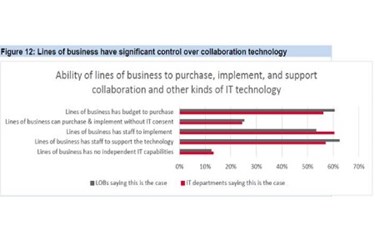Line Of Business Managers In Organizations Play A Key Role When Deciding Which Collaboration Technology To Use

New research says six out of ten lines of business have their own budget – independent of IT - to purchase collaboration technology
New research published recently by Dimension Data reveals that ³line of business managers at many enterprises are taking more control over the technology they need to conduct business. And when it comes to formulating a company’s ¹collaboration strategy, an astounding 89% believe that line of business managers and other non-IT executives have an unprecedented role in defining and executing their company’s collaboration strategy. Furthermore, the influence of these executives is increasing.
Dimension Data’s new 2016 Connected Enterprise Report provides an overview of the state of collaboration implementation strategies, and highlights trends and disruptions in enterprises across the globe. The findings are based on a study of 900 participants in ²15 countries. Survey participants include IT directors, CIOs, and line of business managers working in organizations with over 1,000 employees.
Traditionally, selecting, purchasing, and implementing collaboration technology has been in the hands of IT. The IT department, after all, has the technical expertise around systems and software, and the budget to buy it in the first place. But this trend is changing.
Most IT departments still play a very prominent role in steering their company’s course toward collaboration. Of the 900 participants polled, 60% of enterprises said the CIO and IT directors responsible for communications technology are chiefly responsible for crafting the collaboration strategy, while IT managers in charge of business applications tend to be actively involved as well. This underscores the increasingly software-centric nature of collaboration technology and its impact on business applications that are not themselves communications- nor collaboration-centric.
Nearly six out of ten line of business managers have their own budget – independent of IT – to purchase collaboration technology
More than half of lines of business have staff within the department to implement and support collaboration technology
Brian Riggs, principal analyst, Enterprise Services at research firm, Ovum, says fewer line of business managers are authorized to purchase collaboration technology without the knowledge and consent of the IT department”. This speaks to the ongoing role that IT can play in the technology decisions made by various departments and business units in an organization. Of those enterprises we polled, 24% said lines of business can purchase and implement collaboration technology without the approval or involvement of their IT departments. This points, to a certain degree, to the autonomy that line of business managers have over what tools are provided to their workers to collaborate with each another.”
Joe Manuele, Dimension Data Group Executive, Customer Experience and Collaboration Business Unit, says it’s a situation that could challenge IT departments that want to exercise a high degree of control over the collaboration technology is use within their company. “However, it also has the potential benefit to quickly get the right tools in the hands of those who need them. Line of business managers are much more familiar with how employees in their departments interact with each other, as well as with partners and clients. With that knowledge, they can identify what collaboration tools would best improve their workflow, and implement them independently.”
About Dimension Data
Founded in 1983, Dimension Data plc is an ICT services and solutions provider that uses its technology expertise, global service delivery capability, and entrepreneurial spirit to accelerate the business ambitions of its clients. Dimension Data is a member of the NTT Group. For more information, visit www.dimensiondata.com.
¹ As a set of technologies, collaboration includes tools that provide real-time voice and video communications, as well as text-centric tools for messaging, file sharing, project management, and social networking
² Australia, Benelux (Belgium, Luxembourg, Netherlands), Brazil, Canada, France, Germany, Hong Kong, India, Malaysia, Mexico, Singapore, South Africa, Spain, UK, US.
³ Lines of business comprise business units, regional divisions, functional departments, or other non-IT parts of the organization.
Source: Dimension Data
